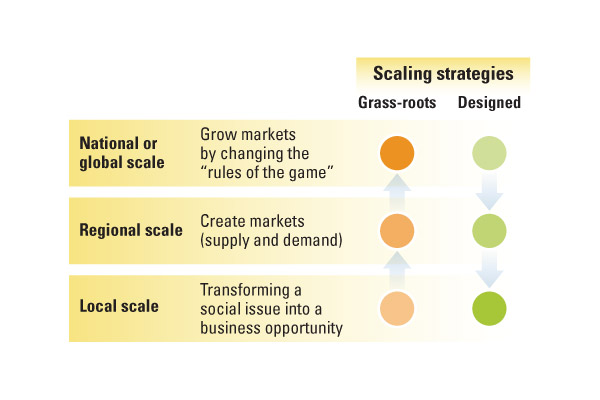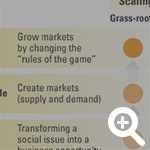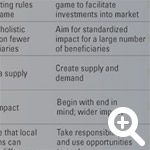What Companies Can Learn From Social Scalers
Social entrepreneurs show that big results can come from small initiatives.
Topics
Leading Sustainable Organizations
Many companies with Corporate Social Responsibility (CSR) programs are striving to scale their contribution to solving the world’s social problems such as poverty, environmental concerns, health — the list goes on. In this article, we describe what these companies can learn from a special breed of social entrepreneur, whom we call “social scalers.”
Like social entrepreneurs, social scalers focus on market-based solutions that do not consume the scarce resources of donors and government agencies. But social scalers are able to go well beyond the social impact normally achieved by social entrepreneurs, even in regions of the world characterized by weak institutions and nonfunctioning markets.
Consider, for example, Tasso Azevedo, who is one of the most successful Brazilian social entrepreneurs working to protect the Amazonas region. After receiving an award for creating a nonprofit that had generated significant impact, he turned to one of the authors and whispered, “To be honest, the nonprofit for which they are giving me this award is not so important. I created it because no nonprofit like it existed. Afterwards, I created a company. Next, I need to change the laws. The Amazonas is a complex region that needs different types of institutions.”
As Peter Drucker observed long ago, social entrepreneurs transform social problems into business opportunities. But social scalers like Tasso do more than that. They address social issues on a national or global scale.
We recently interviewed social entrepreneurs associated with VIVA Trust to understand what they did and how they did it. The VIVA Trust was established by Stephan Schmidheiny, founder of the World Business Council for Sustainable Development (WBCSD), to demonstrate how sustainability goals can be realized. It has a network of more than 6,000 social entrepreneurs of which we interviewed 45 successful social scalers from 9 Latin American countries.
Strategies of social scalers
Social scalers neither work outside of markets like most foundations, nor within functioning markets like the CSR efforts of many companies, nor between civil society and markets like social businesses. They act where markets do not work and follow either a “grass-roots” or a “designed” scaling strategy (see Figure 1).
Figure 1: Two Scaling Strategies

Grass-roots scaling strategy
A grass-roots scaling strategy, as its name implies, starts with low-level involvement; the ambition to scale emerges later, after the social entrepreneur achieves grass-roots success.
Albina Ruiz, a world-renowned social entrepreneur from Peru, is an example. Ruiz grew up in the Amazon region of Peru. When she moved to Lima to study, she was shocked to see the amount of trash in the streets and began to invest more and more time in what she called “healthy city” (ciudad saludable) initiatives. However, she soon reached her limits in terms of her available time and money.
One day, she noticed that the people living on the garbage piles were primarily families with small children and elderly people. Ruiz also saw hope, however, in that people were collecting the trash to sell it and earn a little money. She had found the solution to cleaning up the city: She would train people in recycling to make their collection efforts more effective. The poor would become professionals who could sell their products to recycling companies, thus increasing their income. Albina transformed the social problem of trash into a business opportunity. She then transformed poor people into entrepreneurs who could sell a viable product.
In such local- or regional-focused grass-roots strategies, social scalers eliminate the “middleman” role of the nonprofit. They cease to be a social intermediary between beneficiaries and donors, and instead link them directly by transforming them into sellers and buyers. For example, Albina took this step when she began to help recycling companies gain direct access to the low-income recyclers. Before this, low-income recyclers had no choice but to sell their products to local slumlords under unfavorable financial conditions. With the companies directly engaged, the low-income recyclers could sell their products directly to them.
Building on such successes, the next step is to scale up into a national or global-scale effort that focuses on changing the rules of the game. These rules are defined by laws and regulations, as well as by institutions such as auditors who provide certifications, career advisors who provide the collection and analysis of information, and brokerage companies that facilitate negotiations. Particularly in emerging economies, these institutions often do not function properly; thus, filling institutional voids can stimulate market growth.1
This brings us back to Albina Ruiz and her “clean city” initiative. She began lobbying for the creation and implementation of a law that would legalize recycling as a profession, making recyclers eligible for social benefits. With this law in place, low-income recyclers became formal workers, stimulating many others to enter the newly created profession. Albina also created a university course to educate the recyclers, for which they received an official certification.
Designed scaling strategy
In a designed scaling strategy, the ambition to scale is designed into the scaling strategy at its inception. An example of a designed scaling strategy at the global scale is the Social Progress Index (SPI). The SPI provides a holistic, objective, outcome-based measurement of a country’s well-being, independent of economic indicators. The index changes the game rules, as it measures the social progress of a country, then compares these numbers with its Gross Domestic Product (GDP). It also defines, for each country, the areas with the most urgent need for improvement, such as basic education or access to water. This influences the decision-making of the concerned governments, businesses and nonprofits.
The SPI is more than an index, as it actively supports the creation of national groups that enable the creation of regional markets based on the results of SPI. To this end, an SPI team actively helps the government, private, and nonprofit sectors to more effectively collaborate and negotiate, in turn making better use of their available resources to solve pressing social and environmental problems.
When game rules do not support local markets, the designed strategy transforms social issues into business opportunities at the local level. The SPI, for example, helped Coca-Cola transform its CSR approach by enabling measurement of the social needs at the local level.
What companies can learn from social scalers
To scale their contribution to address the world’s social problems, companies can learn from the social scalers’ RECIPE for doing so (see Figure 2).
Figure 2: The RECIPE Model

1. Rules
Most social entrepreneurs start with a solution to a problem and then try to find someone willing to donate money to support it. Thus, they act within the existing “rules” of the nonprofit sector in which nonprofits act as social intermediaries between donors and beneficiaries. Similarly, in most companies, the standard “rule” for helping to address the world’s social problems is a budget for CSR activities.
Companies can, however, act like social scalers by changing the rules in order to magnify their CSR impact. For instance, FIFCO, a Costa Rican brewery and retailer, changed the rules of the game for CSR contributions by tying compensation for all levels of managers to their performance on three dimensions: economic (50% weight), ecological (30%), and social (20%).
Companies can also change the industry’s CSR rules. Social scaler Paul Rice, the founder and president of Fair Trade USA, for example, changed the rules for market pricing by educating consumers.
2. Engage
Social entrepreneurs typically offer their services to relatively few beneficiaries. One can find this pattern also in the CSR practices of many companies. Following the example of social scalers, however, companies could search for standardized and simple solutions, like Jorge Gronda did with his organization Sistema SER.
Gronda, a gynecologist from Jujuy in northern Argentina, felt that the public health system was failing to help the poor, so he made a widespread call for a private health care system that would serve the poor. He recognized the opportunities that being a well-known doctor afforded him and used his reputation to engage doctors from the private system.
To do this, he created a simple, standardized solution — a health care card that identified patients and doctors in the system. Doctors had an incentive to participate, because it helped them scale their services. Instead of attending to one or two patients a day, at a high price and with a delay in payment from health insurance intermediaries, Gronda’s new system enabled doctors to see several patients a day, each at a very low price, but with immediate payment for their services.
3. Create
Social entrepreneurs address an existing demand or need by creating a supply, like a restaurant that employs people with disabilities. Social scalers, on the other hand, create supply and demand and link them together.
For example, Sounds of the Earth (Sonidos de la Tierra), founded by Luis Szaran, helps poor communities in Paraguay to socially progress according to their own resources and strengths. As a world famous conductor, Szaran began to teach young people from rural villages to play instruments. More important than perfection, he felt, was the experience of playing in an orchestra. To that end, he involved parents in organizing infrastructure for village orchestras.
By personally promoting the orchestras, he created a demand from neighboring villages, who then invited these orchestras to play. He was able to link supply and demand by creating an ecosystem in and around poor communities that helped inspire change. Companies do not have to wait for market needs to emerge; they can actively educate clients and, like Szaran, link demand to supply.
All companies use marketing to understand customer needs and advertising to create demand, and then link demand to supply either by producing and selling the product or service themselves, or by providing either a “platform” (such as Gronda’s health care card) or serving as an intermediary (as Szaran did) to link supply and demand. What is special and different about social scalers is that they focus on understanding customer needs and creating demand where distribution channels and supply chain logistics are either under-developed or nonexistent. In short, the difference is not in the practice of marketing and advertising as such but in how social scalers create markets and build the necessary infrastructure and institutions to serve them in parts of the world where neither exist.
4. Impact
Most social entrepreneurs focus on local impact. In a similar vein, many CSR investments start very small and receive a bigger budget if they succeed. To follow the example of social scalers, companies could start with scaling as the end goal.
5. Perceive
Social entrepreneurs typically focus on local solutions. Social scalers, on the other hand, perceive opportunities to scale up and feel a sense of responsibility to do so. The example of Gronda suggests that companies can do the same.
6. Execute
Social entrepreneurs typically focus on the formation and growth of a single organization. Companies who follow social scalers, on the other hand, could focus on creating, transforming and/or managing the various organizations that are needed to scale social progress. Tasso Azevedo, Albina Ruiz, Jorge Gronda, and Luis Szaran are examples of social scalers who created and collaborated with many different organizations.
More is needed
Companies can address the world’s social problems on a national and even a global scale by following either a grass-roots or designed strategy (Figure 1). They can follow the example of successful social scalers, as summarized in the RECIPE model (Figure 2). Those companies that do this — call them the “corporate social scalers” — can turbocharge the efforts of social scalers such as those described in this article, to help solve the world’s multiple, massive social problems.
References
1. Khanna, T., & Palepu, K. G. (2006). Emerging Giants. Building World-Class Companies in Developing Countries. Harvard Business Review, October, 60-69.


 View Exhibit
View Exhibit View Exhibit
View Exhibit